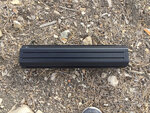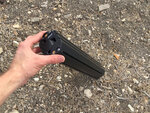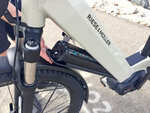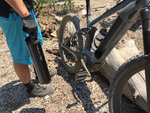Hi guys, I'm creating mini reviews for hardware like the Bosch PowerTube 500 that is shared across many electric bikes. This tactic allows me to go deeper, make updates in one place vs. having details spread out across reviews potentially going out of date, and it aggregates your excellent comments and input to be shared more effectively. There are variations in implementation and end product design, which I'll highlight back in the full ebike reviews on EBR.
The first Bosch PowerTube 500 that I saw in the wild was on the BULLS SIX50 EVO AM 3 in 2018. It offered several important benefits compared with the external PowerPack 500 including the following:




The Bosch PowerTube 500 is filled with 18650 sized lithium-ion cells from leading manufacturers like Samsung, Panasonic, Sony, and LG. I have asked the company several times which brand it uses most frequently, but I think they keep it a secret so that they can switch with demand increases. The big takeaway here is that they use high quality A and B rated cells that should provide more charge cycles and more stability. The cell configuration is 10 series, 4 parallel (10s4p) for both the PowerPack 400 and PowerPack 500 and PowerTube 500 with lower capacity 2500mAH cells in the 400 and 3800mAH cells in the 500. To maximize the lifespan of most lithium-ion batteries, it's best to store them in a cool dry location and avoid letting them fully discharge. Extreme temperatures can degrade the chemistry, you may notice that they do not offer maximum range on very cold days for example. Wait to charge a very hot or very cold battery and target the 20% to 80% fill to avoid stressing the cells. I have noticed that most ebike batteries come charged to roughly 50% on new ebikes and this may be the result of cost savings (since electricity isn't free) along with reducing stress by extended holds of 100% or 0%. Hybrid and electric cars utilize advanced battery management systems that maintain packs between 20% and 80% to reduce stress, and this is part of why they typically hold up so well for so long.
I did some research and discovered that both the vertical and horizontal Bosch PowerTube designs are available in North America. You can see horizontal with Trek, vertical bottom mounting with BULLS, and vertical top mounting with Riese & Müller. Also, I have seen threads and articles where people opened Bosch batteries to see the cells inside, but this is strongly discouraged because it could result in electrical shock, fire, and will void the warranty. If you have any issue with your PowerTube or PowerPack Bosch ebike battery, it is best to visit a Bosch certified dealer for help. They will diagnose the issue by plugging into a professional diagnostic tool, which will send an error and prompt them to recycle it and then warranty with a replacement or sell you a new one.
This review is still in the works, I invite your input below to make this as comprehensive as possible.
The first Bosch PowerTube 500 that I saw in the wild was on the BULLS SIX50 EVO AM 3 in 2018. It offered several important benefits compared with the external PowerPack 500 including the following:
- Internal battery designs usually position weight lower than external packs
- The battery is visually hidden, providing a stealthier design to help ebikes blend in
- The battery is physically protected, I've heard that the PowerPack 400 and 500 could occasionally detach from the bike in a hard crash and that won't happen as easily with the PowerTube
- More space is left on frame tubing (usually the top tube) for bottle cage bosses, frame bags, and this often makes frames easier to lift and hang on certain types of racks
- Durable plastic casing with integrated handle, it's easy to handle and transport and I've been told that Bosch even drop-tests their battery packs for durability, they have a great track record of safety
- Integrated 5-LED charge level indicator, even when the pack is not mounted to an electric bike, you can get a rough idea of how full it is
- Can be charged while mounted or independently, the charging port is very durable and uses a proprietary plug that won't get mixed up with other chargers
- I have seen ebikes from Riese & Müller that utilized two PowerTube 500 batteries for extended range and even mixed and matched one PowerPack 500 with one PowerTube 500 and the Bosch system can handle this, the controller even balances the packs while discharging to reduce cycles on one battery over the other
- Can be charged with the standard fast 4 amp charger or a lighter, smaller 2 amp charger for travel situations, both are light, compact, and UL Certified
- All Bosch battery packs are UL Certified for safety and backed by a large, well established corporation
- Weighing ~6.3lbs without any additional casing, the PowerTube 500 is roughly 0.6lbs heavier than the same capacity PowerPack 500, which weighed ~5.7lbs. Once you add an alloy plate to the outside, as Bulls does with many of their models, it can weigh ~7.2lbs. Trek added an alloy plate as well as plastic end caps and a flip-out handle for safer transport which weighs ~7.3lbs total. To be fair, the alloy plate may not have a big net effect on overall bike weight because the frame might have otherwise had alloy there anyway. Some models from Riese & Müller use plastic covers for their PowerTube battery design as you can see with the Supercharger here. One might argue that in order for the frame to be strong enough to have a bit long cutout, additional materials had to be added that also add weight... so the plastic or alloy covers are still incrementally more than if it were a simple plastic external pack like the PowerPacks. Regardless... the PowerTube 500 definitely weighs more than the PowerPack 500 when it is being transported independently.
- There's no handle built into the battery pack by default, so it's not as easy to lift and transport. The PowerPack 500 had a plastic loop at the top, making it very easy to lift and carry. Some companies are adding a strap and others are adding plastic handles to their PowerTube 500 designs, but this adds to the weight and size
- The PowerTube 500 is physically larger than the PowerPack 500 and may not be as convenient to transport as a spare. It's long and the default casing is angular vs. smooth. I don't think it would fit into a backpack, trunk bag, or panniers as comfortably.
- It's not as easy to rent or borrow because each company has developed a unique way to implement into their frame design. With the PowerPack 400 and 500, the size, mounting interface, and even the colors were largely the same. You could even use them interchangeably. That's not so easy when you look at the PowerTube, because it has a side mount or bottom/top mount casing that is slightly different and each company is developing a shield or cover that is unique... even between models from the same company, there is variation in shield colors. This makes it much harder to rent or borrow, and is a big letdown for people who want to travel on planes with their electric bikes because you cannot usually bring your own battery. Finding a perfect match on location has become very tricky now whereas with the PowerPack 400/500 it was extremely easy and convenient. Replacements were also easier to come-by and less expensive when you consider that you didn't need to buy special color matched shielding.




The Bosch PowerTube 500 is filled with 18650 sized lithium-ion cells from leading manufacturers like Samsung, Panasonic, Sony, and LG. I have asked the company several times which brand it uses most frequently, but I think they keep it a secret so that they can switch with demand increases. The big takeaway here is that they use high quality A and B rated cells that should provide more charge cycles and more stability. The cell configuration is 10 series, 4 parallel (10s4p) for both the PowerPack 400 and PowerPack 500 and PowerTube 500 with lower capacity 2500mAH cells in the 400 and 3800mAH cells in the 500. To maximize the lifespan of most lithium-ion batteries, it's best to store them in a cool dry location and avoid letting them fully discharge. Extreme temperatures can degrade the chemistry, you may notice that they do not offer maximum range on very cold days for example. Wait to charge a very hot or very cold battery and target the 20% to 80% fill to avoid stressing the cells. I have noticed that most ebike batteries come charged to roughly 50% on new ebikes and this may be the result of cost savings (since electricity isn't free) along with reducing stress by extended holds of 100% or 0%. Hybrid and electric cars utilize advanced battery management systems that maintain packs between 20% and 80% to reduce stress, and this is part of why they typically hold up so well for so long.
I did some research and discovered that both the vertical and horizontal Bosch PowerTube designs are available in North America. You can see horizontal with Trek, vertical bottom mounting with BULLS, and vertical top mounting with Riese & Müller. Also, I have seen threads and articles where people opened Bosch batteries to see the cells inside, but this is strongly discouraged because it could result in electrical shock, fire, and will void the warranty. If you have any issue with your PowerTube or PowerPack Bosch ebike battery, it is best to visit a Bosch certified dealer for help. They will diagnose the issue by plugging into a professional diagnostic tool, which will send an error and prompt them to recycle it and then warranty with a replacement or sell you a new one.
This review is still in the works, I invite your input below to make this as comprehensive as possible.
Last edited: